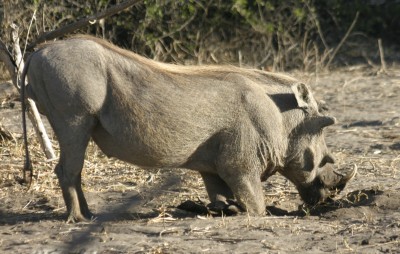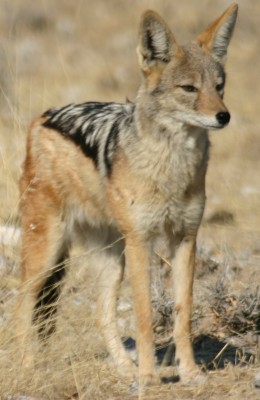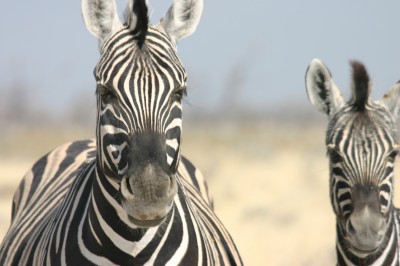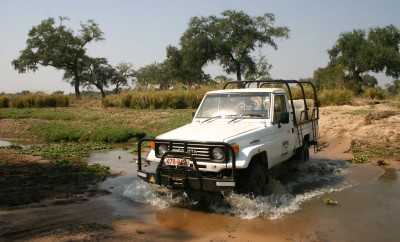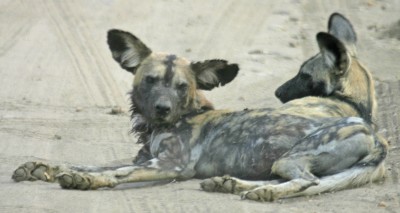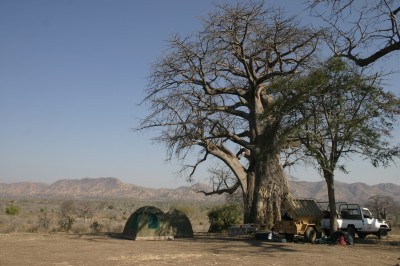My month long safari in Namibia, Botswana and Zimbabwe winds to an end. It is hard to end and say goodbye to Africa. As I sit beside the pilot in the tiny airplane with room for only four passengers, I think of all the impressions, adventures, beauty and thrills I have been treated to. I think of the sun setting for the last time and the animals turning their backs to me. They must get on with their work of survival in the bush and I must fly home to civilisation.
22 All’s well that ends well
Africa Posted on 23 Apr, 2011 12:06- Comments(0) https://travels.insidestory.dk/?p=118
21 Natural art
Africa Posted on 16 Apr, 2011 14:16A safari in Africa puts a perspective on things. Time seems to stand still; the circle of life and death is eternal. The fate of prey and predators interlock. Rains, dry seasons, fires and plant growth maintain life and death.
I see, again and again, that Nature is the ultimate creator, the greatest artist, the smartest inventor. No more words from me this time around – I will let the photos speak for themselves.
- Comments(0) https://travels.insidestory.dk/?p=119
20 Dinner in a tree
Africa Posted on 08 Apr, 2011 13:36
Camp rumour has it that a leopard has killed an impala and dragged the carcass up in a tree in the camp. Katerina the American artist and I go for a stroll to see if we can see anything. We find the impala in the tree, its eyes empty and glazed over with death, its neck broken and throat bloodied. There is, however, no sign of the leopard.
We realize this is our first time wandering around without the security of Mike’s or Bernard’s company and that predators can be about, so we make our way back to the safety of our camp.
The afternoon’s foray brings our little group back to the leopard tree, as we come to call it. We bring the car, camp stools and cameras and hunker down with books and cups of tea. We lie in wait for the leopard that is sure to return to fetch its meal in the tree. It turns out that it is hiding in the tree next to the tree with the impala kill.
Meanwhile, an elephant decides to have a meal here, too. It tears down branches, chomps leaves and gets closer and closer. Finally, we decide it is getting too close for comfort. Mike tells us to be ready to leave at a moment’s notice. I close my book and pack my camera in my backpack. Suddenly Mike says “Go! Move, move, move!” with so much urgency in his voice that my adrenaline level shoots up.
We walk quickly away, circumventing a termite mound to get back to the safety of the car. I trip on a branch and fall flat on my face, pricking my hands, all the while thinking of the elephant. Is he going to trample me? Is he right behind me? Where is he?
With the group safely back in the car, Mike and Bernard make quick dashes back to our spot to pick up the camp chairs, cameras and backpacks that got left behind in the rush.
Later on, as we drive around to find a better place from which to stake out the leopard tree we get a great view of a second leopard lying in the grass. We find a spot to park and stay in the car to watch the scene unfold. Leopard no. 2 approaches, climbs up to the impala carcass and starts to eat. Bits of meat and entrails drop to the ground to the great delight of four hyenas who have been hanging around waiting for just this moment.
- Comments(0) https://travels.insidestory.dk/?p=120
19 Elephants – friendly and wary
Africa Posted on 02 Apr, 2011 18:54We regularly meet elephants. Some of the meetings are rather too close for comfort. Other times we meet elephants that are simply benign and friendly and doing their thing which is, for the most part, eating. Elephants spend about 20 hours a day eating, in contrast to the lazy lions that spend about 20 hours a day sleeping.
One day we plan to enter a dense forest where we may be able to spot nyala antelope. It is also a good place for elephant to hang out because it is shady and there is a lot of luscious green food for them to eat. However, the forest cover also makes it hard for us to see the elephants before we get too close to them. Mike and Bernard decide to go in first to case the joint, so to speak. About a minute later they comes rushing back towards us and tell us to go back to the car. It seems there was an elephant with her approximately two-week old calf. Surprising her with a face to face meeting could have been a very dangerous situation.
At our lunch break back at camp we meet a friendly giant. An single elephant with beautiful, large undamaged tusks saunters along the riverside, which is where everyone has pitched their tents. One by one, he passes each tent and I can figure out that he will soon walk past me. I move out of his way behind my tent as he passes within five metres of me, padding softly by on his huge, pillowed feet. What a majestic beast!
Another day we watch how these social and intelligent animals help each other. One bull elephant has lost the bottom part of his trunk, probably due to a snare. With a shortened trunk it is very difficult for him to reach his mouth and stuff food into it. It is also hard for him to gather branches and twigs from the ground and the trees. This is where his buddy comes to the aid. The other bull elephant pulls down branches and gathers the leaves in a pile, in effect serving dinner to his handicapped friend as best as he can. Very touching!
- Comments(0) https://travels.insidestory.dk/?p=121
18 Wild dogs and silly hyenas
Africa Posted on 27 Mar, 2011 13:59After the days of remote beauty at the Chitake campsite we break camp and leave to set up camp by the Zambezi River at Nyamepi Camp. I will not miss the tsetse flies at Chitake and I am pleased to be down in the river area again, in the company of hippos. The area here is lush and green. The downside at Nyamepi is that there are other people.
Anyway, we go for walks and game drives and see loads of animals. We spend dusk hours watching a pack of 10 African wild dogs. They while away the time trying to sleep but constantly waft their tails and shake their heads to keep the bugs away. They can find no rest.
Suddenly a few of them get up to urinate and defecate. This is a group thing. They sniff and roll in each other’s pee and poop in an effort to smell like each other. I will not comment on what I think about that kind of social behaviour. They then greet each other nose to nose, growling aggressively then yipping submissively.
In wild dog groups there is a dominant male and a dominant female who get to have all the fun. If the other females deign to have pups the dominant female will usually kill those pups. Females usually emigrate from the pack (often dying) while males hang around waiting to take over the leading role. Pups have fun while they can, rolling around and tussling with each other just like domestic dogs.
Hippo for dinner
Another day we happen upon an interesting scene. We smell and then see a dead hippo. It is lying in the shallow river on a green bed of water hyacinths, bloated, stinky and feet up in the air. A few hyenas have also spotted the hippo and think “dinner”. This is easier said than done. The hyenas are chickens at heart and spend ages getting up the nerve to dip their feet in the river. “What if a lion comes by? What if I drown? What if I someone catches me?” they seem to ask themselves.
The lure of food overcomes their fears and they finally venture into the river. They clamber onto the hippo carcass and try to break through the skin. This is tough. The hide of the hippo is very thick and even though hyenas have a strong bite they find it hard to pierce the skin. At the same time, the hyenas have trouble keeping their balance on the curved and slippery surface of the hippopotamus. One of them slides off into the water and look frustrated and embarrassed.
Egoists that they are, they occasionally fight each other for the carcass. They pull at it, but in each their direction. If they worked together instead of against each other, they could drag it up onto the riverbank and have a much easier job of eating. Meanwhile, the vultures are gathering. White-backed vultures, hooded vultures and marabou storks make up a grim audience to the comical show.
- Comments(0) https://travels.insidestory.dk/?p=122
17 Wild walks in the wilderness
Africa Posted on 20 Mar, 2011 10:50We walk in the silent heat. At 5:30 am it was nice and cool but already by 10:00 am it is hot and by 11 it is scorching. The tsetse flies are active, attracted by the blue colour of my backpack, by the smell of my sweaty skin, and the prospect of yet another fresh meal of blood. They drive me crazy!
Our guides Mike and Bernard see things I do not until they are pointed out to me: the age, size, type and direction of footprints in the sand, the freshness and composition of animal droppings, traces of broken branches, trampled leaves, discarded bones and lost feathers. They can read the bush like a book, while I am still learning the alphabet.
We see tracks, trees, seeds, pods, plants, dung, bones and birds. I pick up feathers, seeds and porcupine quills for my collection. We spot dwarf mongoose, warthogs, a large herd of impala, and vultures circling in the air.
One morning we follow fresh lion prints – large indentations in the sandy soil. We are awarded. A young male, with a Mohican hairdo and his girlfriend are enjoying some quality time with each other. We hope to see them mate but all of us are disturbed by a couple of other groups of walkers approaching the harmonious couple from two different directions. I can understand why the lions would feel a bit shy in the midst of all this attention. The male lion gets up and walks towards one of the groups. From behind the trees we hear him growl at them.
That night we hear the lions roar and the hyenas laugh. Next morning I am wide awake within seconds.
“Do you want to chase lions?”
Mike scratches on my tent, asking this provocative question at 5:30 am. Of course I want to chase lions! In the dark I make a mad dash to get into my clothes and hurriedly join the others, ready for an exciting start to the day. We see from footprints in the sand that the lions strolled very close to our camp during the night.
We follow the prints until we get close to the big cats. It is the same couple as yesterday. Bernard moves closer to them at an angle to see if we can all get closer without being seen. Meanwhile, the rest of us stay put with Mike. Suddenly, the lions spot a movement in our group.
The male stands up, tail flicking angrily, all of his impressive muscles tensed, shaggy Mohican mane making him look very manly and threatening. He struts a couple of steps towards our little group, his fierce yellow eyes making eye contact with us.
His mighty, reverberating roar sends us scurrying behind Mike who gets his rifle at the ready in a wink. Bernard quickly sneaks back to us, prepared to help Mike. We start to walk slowly back to our camp, but the lions cut off our route and the male roars again – a deep, booming, large sound that fills out all the space and makes my heart flutter and my knees weak. We must choose another route.
Phew! What a morning!
River life and death
Several times during our stay at Chitake we take a walk down to the river. Well, it would be more apt to call it a dried out riverbed because at this time of year there is not much water. There are, however, puddles here and there and lovely pink rock formations. We huddle behind branches and trees, waiting to see wildlife coming for a drink.
We spot mostly baboons, pigeons and guinea fowl. In the riverbed we also see and smell death, which is an integral part of bush life. A buffalo skeleton lies rotting with its white-toothed grin.
We have spotted a couple of things that are new for me – a Sharpe’s grysbok, which is a small antelope weighing about 7,5 kg, and some pottery shards, which attest to the fact that this area has previously been inhabited.
- Comments(0) https://travels.insidestory.dk/?p=123
16 Under the baobabs
Africa Posted on 13 Mar, 2011 11:41We have broken camp at Muchemi Campsite by the Zambezi River and moved deeper into the wilderness of Mana Pools, setting up camp at Chitake Campsite. Majestic baobabs abound. So do the beastly tsetse flies and the irritating mopane flies. At dusk bats swoop by and owls hoot. Night time has its own symphony of lion, elephant, hyena and baboon sounds.
The camp at Chitake is very remote. It is as though we have the whole land to ourselves. It is also very primitive – which is just my cup of tea. I have set up my tent in the shade of an enormous, ancient baobab tree. It is my sentinel.
Mike and Bernard have dug a hole in the ground under another huge baobab. On top of the hole they have placed the toilet chair – a toilet seat with four legs. A more magnificent loo view is hard to find. The shower area consists of a bucket with warm water and a tarpaulin tied to a couple of trees. Washing myself while enjoying a moonlight view of the Zambezi escarpment gives more enjoyment than just a feeling of cleanliness.
The group of people I am with are interesting, friendly and well-travelled. There are a couple of German psychotherapists, a German management consultant and an American artist living in Italy and Zambia (check out her amazing artwork here). We walk together, talk together, eat together. We all get up at 5:30 in the morning and all go to bed early. We all read our books, snooze in our tents, and scratch our tsetse fly bites during the long and sweltering midday siestas. We all love this place called Mana Pools.
- Comments(0) https://travels.insidestory.dk/?p=124
15 Nature’s juxtapositions
Africa Posted on 05 Mar, 2011 14:41The wrinkled eye of an elephant looks like bark on a tree. The rhomboid pattern on a giraffe looks like cracked, dry earth. A sunset flames like a bright red flower. A desiccated tree root is shaped like a wind-dried skull, the colours and shapes on the shell of a slow-moving tortoise are like those on a graceful giraffe and the speckles on three crowned lapwing eggs are similar to guinea fowl polka dots.
Nature recycles her good ideas.
- Comments(0) https://travels.insidestory.dk/?p=125





